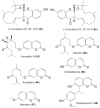Ferula sinkiangensis (Chou-AWei, Chinese Ferula): Traditional Uses, Phytoconstituents, Biosynthesis, and Pharmacological Activities
- PMID: 36840251
- PMCID: PMC9958602
- DOI: 10.3390/plants12040902
Ferula sinkiangensis (Chou-AWei, Chinese Ferula): Traditional Uses, Phytoconstituents, Biosynthesis, and Pharmacological Activities
Abstract
Ferula is the third largest genus of the Apiaceae family, its species are utilized as a remedy for diverse ailments all over the world. F. sinkiangensis K. M. Shen (Chou-AWei, Chinese Ferula) is mainly found in Xin-jiang Uygur Autonomous Region, China. Traditionally, it is utilized for treating various illnesses such as digestive disorders, rheumatoid arthritis, wound infection, baldness, bronchitis, ovarian cysts, intestinal worms, diarrhea, malaria, abdominal mass, cold, measles, and bronchitis. It can produce different classes of metabolites such as sesquiterpene coumarins, steroidal esters, lignans, phenylpropanoids, sesquiterpenes, monoterpenes, coumarins, organic acid glycosides, and sulfur-containing compounds with prominent bioactivities. The objective of this work is to point out the reported data on F. sinkiangensis, including traditional uses, phytoconstituents, biosynthesis, and bioactivities. In the current work, 194 metabolites were reported from F. sinkiangensis in the period from 1987 to the end of 2022. Nevertheless, future work should be directed to conduct in vivo, mechanistic, and clinical assessments of this plant`s metabolites to confirm its safe usage.
Keywords: Apiaceae; Ferula sinkiangensis; bioactivities; biosynthesis; responsible consumption and production; sesquiterpene coumarins; sustainability; traditional uses.
Conflict of interest statement
The authors declare no conflict of interest.
Figures


























References
-
- Balick M.J. Transforming Ethnobotany for the New Millennium. Ann. Mo. Bot. Gard. 1996;83:58–66. doi: 10.2307/2399968. - DOI
-
- Abdul R.B. Medicinal plants (Importants and uses) Pharm. Anal. Acta. 2012;3:e139.
-
- Sahebkar A., Iranshahi M. Volatile constituents of the genus Ferula (Apiaceae): A review. J. Essent. Oil-Bear. Plants. 2011;14:504–531. doi: 10.1080/0972060X.2011.10643969. - DOI
Publication types
LinkOut - more resources
Full Text Sources

